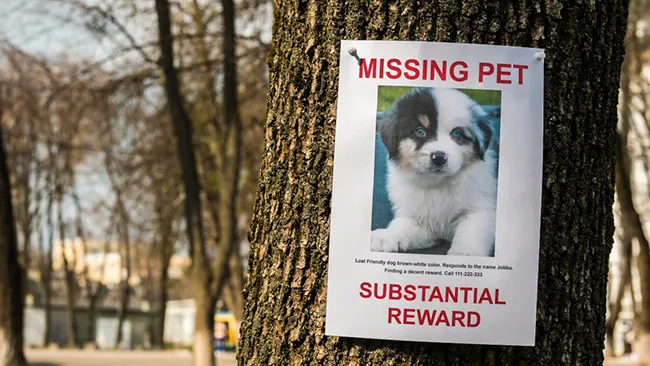
Losing your dog is like losing a piece of your heart—one moment they’re curled up at your feet, and the next they’re nowhere to be found. If you’re wondering how to find a lost dog, take a deep breath and know you’re not alone. Even after the first 24 hours, many pups are safely reunited with their families.
This guide will walk you through simple, heartfelt steps—like retracing favorite routes, tapping into your neighborhood’s caring networks, and using online tools—to bring your furry friend home. With patience, persistence, and a little help from your community, you’ll boost your chances of that joyful tail-wagging reunion. Let’s get started on the search that brings your best friend back where they belong.

Why the First 24 Hours Matter
The good news is that most dogs are found very quickly. Studies show that about 93% of lost dogs are recovered within the first 24 hours of going missing. That means if you act fast—posting flyers, alerting neighbors, and contacting local shelters—you have an excellent chance of bringing your pup back home safely. Even simple steps like checking your yard, leaving out food with your scent, and driving familiar routes can pay off in those early hours. Spread the word using an amber alert for pets service. They can help in searching the nearby areas where your pet may have wandered.
Dog Behavior When Lost
Every dog reacts differently when they’re lost, based on their personality and past experiences. Understanding “lost dog behavior” can help you tailor your search:
- Friendly (Gregarious) Dogs
These pups usually stick close to people and may approach strangers for help. They often don’t wander far. If your dog is outgoing, focus on places with foot traffic and ask passersby to look out for them. - Aloof Dogs
More independent dogs keep their distance and may travel farther from home. They’re wary of strangers, so they might hide in quiet spots. Patience is key—try placing food stations and leave a crate or bedding at the last seen location to lure them back. - Fearful (Xenophobic) Dogs
Dogs with anxiety or past trauma can panic and go into “survival mode.” They won’t respond to their name or favorite toys and may cover long distances in search of safety. In these cases, avoid chasing them. Instead, quietly set up scented traps (like a crate with open doors) and wait calmly for them to come out of hiding.
By knowing these behavior patterns and acting swiftly, you make it much more likely that your lost dog will be found—and found happy, healthy, and safe.
Immediate Actions at Home
When your dog is missing, your home is the first place to search. Acting quickly at home can help you find your pup before they wander too far. Follow these simple steps to make sure you leave no corner unchecked and use familiar comforts to guide them back.
Search Your Property Thoroughly
Before you expand your search to the neighborhood, comb every inch of your property. Dogs often hide in spots you might not expect, especially if they’re scared or injured. Move methodically, room by room and area by area, to ensure you don’t miss a hiding place.
Check Hiding Spots & Inside the House
Begin indoors where your dog feels safest. Look under beds, behind furniture, inside closets, and even in laundry baskets. Don’t forget garages, basements, and sheds—panicked dogs may slip through a slightly open door. Call your dog’s name softly and listen for any rustling or whimpers before you open a closet or lift a blanket.
Leave Familiar Scents & Lures (blankets, toys)
If your dog has already slipped outside or is hiding nearby, their keen nose can still lead them home. Place an item with your fragrance—like a worn T-shirt—by the door. Add your dog’s favorite blanket, toy, or a small bowl of food just inside the entryway. These comforting scents create a scent trail that encourages your dog to return on their own. Check these scent stations often, as your dog may circle back when the yard is quieter.
By combing your home carefully and using comforting scents, you give your lost dog the best chance to find sanctuary and guide them back to you.
Neighborhood Search Strategies
When your dog slips out of sight, your neighborhood becomes the next best place to look. With a mix of careful planning and community help, you can cover more ground and boost your chances of finding your furry friend.
Systematic Perimeter Search
Start by walking a measured loop around your home. Don’t rush—move at your dog’s pace and stay alert for any sign of movement or sound.
Mapping Your Search Radius (1–2 miles)
Draw a simple circle on paper (or mark it on your phone’s map) extending about one to two miles from your home. This range covers most dogs’ wandering distance in the first day. Break the circle into small sections—blocks or streets—and tackle one section at a time so you don’t miss a corner.
Calling Their Name & Using Food as a Lure
Bring your dog’s favorite treats or a bowl of kibble. As you walk each block, call your dog’s name in a calm, hopeful tone. Pause often, listen quietly, and shake the treat bag for a familiar sound. The smell of food may draw your pup out of hiding if they’re nearby.
Flyers & Posters
A well-designed flyer can catch your neighbors’ eyes—and hearts—so they know to be on the lookout.
What to Include: Photo, Description, Contact Info
Use a clear, recent photo where your dog’s face and any unique markings are visible. Add a brief description: breed, color, size, and any collars or tags. Include your phone number in large, bold print—and, if possible, a secondary contact in case you can’t answer.
Best Locations: Parks, Vets, Mailboxes
Post flyers where people already pause and look:
- Community parks and dog-walking trails
- Veterinary clinics and pet supply stores
- Mailbox clusters and community bulletin boards
- Local cafes, grocery stores, and laundry rooms
By combining a calm, systematic walk with clear, friendly flyers, you enlist both your own eyes and your neighborhood’s goodwill. Together, you’ll be one step closer to bringing your best friend safely home.
Leveraging Technology & Online Communities
Finding a lost dog can feel overwhelming, but today’s tools and online networks make it easier than ever to reconnect with your furry friend. Here’s how to tap into microchips, GPS trackers, and social platforms to boost your chance of a happy reunion.
Microchip & Collar Check
Every dog should wear a microchip and an ID tag. A microchip is a tiny device placed under your dog’s skin that stores a unique number. If someone scans your dog, that number points back to your contact details. An ID tag on a collar gives instant info to anyone who finds your pup.
How to Scan & Update Your Dog’s Microchip
- Get your dog scanned: Most vets, shelters, or animal control offices will scan free of charge. They pass a handheld scanner slowly over your dog’s shoulder blades and neck until it beeps.
- Find the registry: Your scanner report will show the microchip number and the database it’s in. If you adopted from a rescue, ask them for paperwork.
- Check your info: Visit the registry’s website or call their hotline. Look up your chip number and review your address, phone, and email.
- Update details: If you move or change numbers, log in to your account or submit an update form. Some registries offer free updates; others charge a small fee. Keeping info current can speed up a reunion if your dog turns up at a shelter or vet clinic.
GPS Trackers & Smart Dog Trackers
A GPS tracker attaches to your dog’s collar and shows you their real-time location on a smartphone app. Many let you:
- Set up a virtual fence that alerts you when your dog leaves a safe zone.
- See tracking history, so you know where your dog has been.
- Choose devices with long battery life (several days on a single charge).
Popular options include:
- Tractive GPS Pet Tracker, known for reliable coverage and simple setup.
- Fi Series 3 Smart Dog Collar, which also records activity and sleep.
- Halo Collar 4, offering geofence alerts and training features.
Pick a model that fits your budget, your dog’s size, and your local cell coverage.
Social Media & Lost-Pet Platforms
Spreading the word fast is key. Post clear photos and your dog’s name, last seen location, and a phone number. Include any special marks or quirks.
Effective Hashtags & Local Facebook Groups
Hashtags help your post travel beyond your friends. Try:
- #lostdog
- #missingdog
- #lostpet
- #founddog
Add your city or neighborhood, for example #AustinLostDog or #BrooklynMissingPet, to reach nearby searchers. Join and post in local community or lost-pet Facebook groups. Neighbors often share sightings before official channels pick them up.
Petfinder, PawBoost, Nextdoor, Petco Love Lost
- Petfinder: A free database where you can list your lost dog. Shelters and adopters also browse here.
- PawBoost: Instantly posts your dog to a large lost-and-found network. It also shares to Facebook and Nextdoor for hyper-local reach.
- Nextdoor: A neighborhood app where you can send “Lost Pet” alerts to everyone in your ZIP code.
- Petco Love Lost: Lets you upload photos and uses facial recognition to match lost and found pets. It also integrates with Facebook, Nextdoor, email, and print-able flyers.
By combining a microchip check, a GPS tracker, and targeted online posts, you’ll cover all the bases. These tools work together to get your dog home—fast and safely.
Contacting Local Resources
Within 24 hours, you’ve scoured the neighborhood and posted online. Now it’s time to tap into official channels and friendly neighbors to widen your search.
Animal Shelters, Rescue Groups & Animal Control
Reach out to every nearby shelter, rescue and animal control office—by phone, email or in person. Provide:
- Clear description: breed or mix, size, sex, coat color and any unique markings or scars.
- Temperament: friendly, shy, nervous or energetic.
- ID details: collar description, tag info and microchip number (if chipped).
- Last seen: date, time and exact location.
- Your contact: best phone number and email.
Ask them to log your report and promise to follow up if a matching dog arrives. Many shelters hold strays for 72 hours; the sooner you report, the higher your chance of reunion.
Veterinary Clinics & Local Dog Wardens
Many good Samaritans bring lost pets to their vet. Also, local dog wardens (animal control officers) record stray reports.
- Call or visit nearby clinics and ask staff to:
- Scan for microchips.
- Check a “found-pet” bulletin board.
- Keep your flyer on display.
Provide the same details you gave shelters: photo, description, microchip and last-seen info.
- Contact your Dog Warden or Animal Control through your city or county hotline.
- They keep a register of reported strays and found dogs.
- Give them your full dog profile, microchip number and temperament so they can match any incoming reports.
Neighborhood Outreach (“knock on doors”)
Your neighbors are your best backup:
- Walk the streets in the early morning or evening. Call your dog’s name softly.
- Knock on doors and ask residents to check garages, sheds, porches and backyards.
- Leave flyers when no one’s home. Use bright paper and a clear photo. Keep text brief: dog’s name, last-seen location, date and your phone number.
- Speak kindly and share a relatable example: “When Luna slipped out last spring, Mrs. Patel heard her bark behind her barn and we found her safe under the hay.”
Offer to swap updates: ask neighbors to text you if they spot any movement. A friendly ask often turns into an extra set of eyes—and one more chance to bring your dog home.
By combining official reports with boots-on-the-ground canvassing, you cover every avenue. Stay calm, stay persistent, and lean on these local resources—your pup could be just around the next corner.
Chances of Finding a Lost Dog After 24 Hours
Losing your dog is a heart-stopping moment, and the first 24 hours are always the most frantic. But what if a whole day has passed and your furry friend is still missing? Take a deep breath—there’s still hope.
The Good News
Many dogs are found safe even after 24 hours. Dogs are smart and resourceful. They often find places to hide, especially if they’re scared or tired. Some friendly pups may even approach strangers for help, while shy dogs might stick to quiet spots until things calm down.
What the Numbers Say
Studies and real-life stories show that about 60% of lost dogs are found within the first 24 hours. But after that, the chances don’t drop off a cliff. In fact, many dogs are reunited with their families days or even weeks later. The odds stay strong if you keep searching and use every tool available.
Why Dogs Get Found
- Microchips and ID tags: Dogs with up-to-date microchips and tags are much more likely to be returned.
- Community help: Flyers, social media posts, and word of mouth can travel fast.
- Shelters and vets: Many lost dogs are brought to local shelters or vet clinics by good Samaritans.
What You Can Do
- Don’t give up. Keep searching your neighborhood, especially early in the morning and at dusk when it’s quiet.
- Update your flyers and online posts. Refresh your message and keep sharing your dog’s photo and your contact info.
- Visit local shelters in person. Sometimes descriptions over the phone don’t match up, so seeing for yourself is best.
- Check back with vets and animal control. Someone may bring your dog in days after they go missing.
- Ask neighbors to look in sheds, garages, and under decks. Dogs often hide in small, quiet spaces.
Stories of Hope
Many pet owners have found their dogs after days, weeks, or even months apart. One family found their beagle after three weeks because a neighbor saw a flyer and recognized him in a nearby park. Another dog was found at a local shelter after being picked up by animal control five days after she went missing.
Keep the Faith
It’s natural to feel worried, but remember—persistence pays off. Your dog is out there, and with each step you take, you increase the chances of a joyful reunion. Stay positive, keep searching, and lean on your community. Your best friend is counting on you!
FAQ.
What are my chances of finding a lost dog after 24 hours?
About 93% of lost dogs are found, even after 24 hours. Your chances are still high, especially if you keep searching and use local shelters, flyers, and social media. Don’t give up—many dogs come home after the first day.
Is it okay to chase my lost dog?
No, you should not chase your lost dog. Chasing can scare your dog and make them run farther away. Instead, stay calm, sit down, and call your dog gently. Let them come to you on their own.
How long should I keep flyers posted?
It’s best to keep lost dog flyers up for at least three to six weeks. This gives people time to notice and respond. Remove flyers once your dog is found or if you move your search to a new area.
Can I legally rehome a stray dog I find?
You cannot rehome a stray dog right away. Most places require you to report the dog to animal control and wait through a “stray hold” period. If no owner claims the dog during that time, you may be allowed to adopt it.
Should I offer a reward?
Offering a reward is a personal choice. It can help, but it may also attract scammers or cause people to chase your dog. Most dogs are found through community help, not rewards, so use caution if you decide to offer one.




